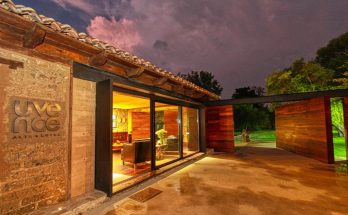Uxmal is a majestic archaeological site located 23 km from Kabah by the federal highway 261 in the State of Yucatan, Mexico.
Uxmal Yucatan
Uxmal is located in the Santa Elena Valley to the south of the Pucc hill country in the southwestern part of the Yucatan Peninsula. The zone was first settled in 500 B.C., but it wasn’t until the ninth and twelfth centuries A.D. that it became the seat of Mayan political and economic power in the Puuc region.
It is estimated that a population of around twenty-five thousand inhabitants was distributed throughout a territory of 37.5 square kilometers with enormous agricultural potential, but lacking in permanent water sources. For this reasons the Mayas constructed chultunes, or underground cisterns, and complex drinking water system, including aguadas and bukteoobob for the utilization of rainwater.

The architecture at Uxmal is one of the most authentic examples of the Puuc style. Decorative features such as the three-dimensional masks of the god Chaac, colonnades, the two-headed jaguar, and other iconographic symbols demonstrate Uxmal’s position in the most important cultural and commercial circuits of the Maya Classic Era.
The walled civic-administrative area occupies an area of one kilometer from north to south and .6 kilometer from east to west. The place-type structures are arranged around courtyards, forming quadrangles. The decoration is among the richest and most varied of all the archaeological zones, including representations of god, animals, dignitaries, and geometric forms. There are also residential structures in the surrounding area.
No doubt, Uxmal is considered as the most splendid archaeological site from the Pre Hispanic era on the American Continent because of the proportions of its majestic constructions decorated with delicate embossment, which are carved with elegance and precision, astounding both, scientific community and visitors, since the Mayan builders had neither metal tools nor detectable means of transportation.
Its foundation date is still undetermined, but archaeologists rough estimates indicate that it was between the fifth and sixth centuries AD. Its cultural development, considered classic, demonstrates a certain similarity to that of Chichen Itza but shows none of the latter’s Toltec influence.

The indigenous chronicles written after the Spanish Conquest name Ahcuitok Tutul Xiu as Uxmal’s founding leader.
Please bear in mind that most place names were assigned to the various structures by the Spaniards. The name Uxmal was provided by the Mayans in their decadent period. Uxmal is divided in three sections
UXMAL CENTRAL ZONE
The Magician’s Pyramid, located at the entrance to the site. This colossus stone is the result of five superimposed stages of building, crowned by a temple at the summit, from which you can contemplate the full grandeur of Uxmal
The Nun’s Quadrangle, so called since the Conquest for its similarity to a convent; comprised of four large structures resting on an artificial platform and surrounding a grand central square, 75mts long by 45mts wide. Decorated with god masks, jaguars, owls and human figures. This is the stage in which takes place the light and sound show.
This name was given to the VVIIth. century. It is comprised of four palaces placed at different levels, which surround the Patio.
Its construction dates from around 900-1000 A.D. The facades offer a rich combination of decorative motifs such as lattice-work, colonnades, huts, masked representations of the Rain God, Two-headed serpents, owls, Symbols of the planet Venus, geometrical elements, human figures, naked or tied up, either sitting or standing. Quite conspicuous are the representations Tlaloc, The Rain God of Central Mexico.
The Ballgame Court
The Cemetery Group
The Temple of the Monuments
The Soothsayers House, The name of this building comes from a Mayan legend known as “The Legend of the Goblin of Uxmal”. The building is about 35 meters high and shaped like a truncated cone. Up till known, five different construction phases, each with a distinctive style have been discovered.
These modifications were undertaken so as to satisfy the functional and religious need of each ensuing period. To the Westerly side one can observe Temples 1, 3, 4 and 5 which are dated between the VIIIth. century and 1050 A.D. Towards the East lies the access to Temple 2, which dates from the VIIIth. century as does the aforementioned Temple 5.
UXMAL ZONA SUR
El cuadrilátero de las palomas
La Gran Pirámide
El Palacio del Gobernador. Construido sobre una plataforma escalonada de 97.5mts de largo por 8mts de ancho y 8mts de alto; supuestamente, la residencia de los miembros más importantes de la clase gobernante. Es extraordinario el efecto visual de movimiento que producen las máscaras del dios de la lluvia que sobresalen de los frisos, así como la filigrana formada por más de veinte mil mosaicos en la fachada.
La Casa de las Tortugas. Este edificio tiene 30 m. de largo y 10 m. de ancho y consta de siete recintos. La decoración es sobria y sus muros inferiores lisos contrastan con las columnatas que decoran la fachada superior, donde, a lo largo de la cornisa, se observan esculturas de tortugas, que eran animales importantes por su asociación con la lluvia y los ciclos de la Tierra. Este templo estaba seguramente dedicado al culto acuático. El estilo arquitectónico corresponde a la última fase del Puuc Floreciente o Uxmal Tardío (900 – 1000 d.C.)
La Casa de la Vieja
El Templo del Phalli (requiere guía)
La Casa de los Chimez (requiere guía)
La máscara de Chac, el dios de la lluvia,
El santuario de la picota. Este santuario está construido sobre un pedestal cuadrado. En el centro hay un monolito troncocónico que parece haber sido estucado y sobre el que se pintaron jeroglíficos y ornamentos simbólicos. Además, también se le conoce como el Bloque de los Azotes.
Existe, por supuesto, una versión simplificada en la que la piedra representa el Árbol Central (“Axis Mundi”), el Ya’ axche Cab. que se menciona en la Mitología Maya. Todo indica que fue construido alrededor de la misma época que el Palacio de los Gobernadores.
Trono del Jaguar. Cada lado de la plataforma tiene 4.85 metros de largo y 1.20 metros de alto. Tiene escalones en los cuatro lados. En el centro se encuentra una escultura de un jaguar de dos cabezas que servía de trono. Las excavaciones realizadas entre 1951 y 52 hicieron posible su restauración y también sacaron a la luz una valiosa ofrenda de su interior. Se encontraron 913 piezas, entre ellas cuentas, pectorales, pendientes de jade, loza, cornalina, piedra negra pulida, cabezas de lanza y cuchillos de sílex y obsidiana.
Gran Pirámide o Templo de las Guacamayas. Esta pirámide truncada se compone de nueve secciones, construidas en diferentes niveles; la parte superior se conoce como el Templo de las Guacamayas porque estas aves tropicales están representadas en la decoración, junto con grecas y filetes ornamentales con serpientes entrelazadas, máscaras de animales grotescos, etc. Esta pirámide data probablemente de mediados del siglo VIII.
UXMAL SOUTH ZONE
The Quadrangle of the Doves
The Great Pyramid
The Governor’s Palace. Built on a stepped platform 97.5mts long by 8mts wide and 8mts high; supposedly, the residence of the most important members of the ruling class. The visual effect of movement produced by the rain-god masks jutting out from the friezes is extraordinary, as well as the filigree formed by over twenty thousand mosaics on the facade is remarkable.
The House of the Turtles. This building is 30 mts. long and 10 mts. wide and is comprised of seven recincts. The decoration is sober and its smooth lower walls contrast with the colonnades that decorate the upper facade, where, throughout the length of the cornice, one can observe sculptures of turtles, who were important animals due to there association with rain and the Earth cycles. This temple was most surely dedicated to Aquiatic Cult. The architectural style corresponds to the later phase of Flourishing Puuc or Late Uxmal (900 – 1000 A.D.)
The Old Lady’s House
The Temple of the Phalli (requires guide)
The Chimez House (requires guide)
Mask of Chac, the Rain God,
The Pillory Shrine. This shrine is built upon a square pedestal. There is a truncated cone – shaped monolith emplaced in the center which appears to have been stuccoed and upon which hieroglyphs and symbolic ornamentation were painted. Besides that, it is also known as the Flogging Block.
There is, of course, a simplified version in which the stone represents the Central Tree ( “Axis Mundi”), the Ya’ axche Cab. which is mentioned in Maya Mythology. Everything indicates that it was built around the same time as the Governors Palace.
Throne of the Jaguar. Each side of the platform is 4.85 meters long and 1.20 meters high. It has steps on al four sides. A sculpture of a Two Headed jaguar, which served as a throne, is placed in the middle. Diggings made between 1951 – 52 made its restoration possible and also brought to light a valuable offering from its interior. 913 pieces were found, including beads, pectorals, Jade earring, earthenware, Cornaline, polished black stone, spear heads, and Flint and Obsidian knives.
Great Pyramid, or Temple of the Macaws. This truncated pyramid is made up of nine sections, built on different levels; the upper part known as the Temple of the Macaws because these tropical birds are depicted in the decoration, together with ornamental frets and fillets with entwined snakes, grotesque animal mask. etc. This pyramid probably dates to the mid 8th Century.
UXMAL NORTH ZONE
Consisting on several, still unnamed mounds. Visitors require guide.

UXMAL SCHEDULE
- Archaeological zone: From 8 to 17 hrs.
- Museum: From 8 to 17 hrs.
- Light & Sound Show in Spanish*:
- Winter Hour: 19 hrs.
- Summer Hour: 20 hrs.
- *You can rent simultaneous translation equipment for English, French, Italian and German; also Mayan translations are available.
UXMAL FACILITIES
- Auditorium
- Guided visits
- Handcraft
- Photographic articles
- Bookstore
- Infirmary
- Toilets
- Restaurant
In Uxmal you can find excellent hotels and tourism services.




